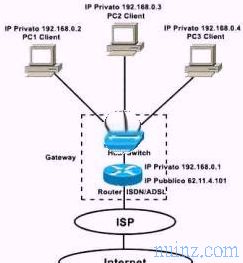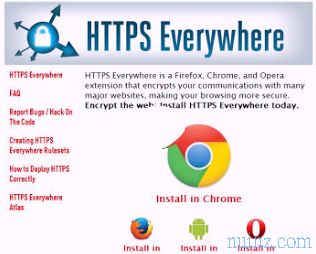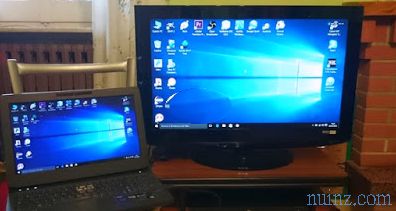Among the most dangerous threats that we can catch on the Internet or by attackers who get physical access in front of our PC, the keylogger certainly stands out, a small software that can record all the keys we press on the keyboard.
It goes without saying that such a threat can be very dangerous when we access home-banking sites or our e-commerce accounts (Amazon, PayPal) by typing a username and password: these will be captured by the keylogger and recorded in text files which can be retrieved via the Internet or physically, thus providing very sensitive information in the hands of unscrupulous offenders.
To avoid this type of threat the best method is not to use the physical keyboard when typing access credentials but one of the many virtual keyboards .
Let's find out the best virtual keyboards that we can use on Windows to increase our security.
READ ALSO -> Best combination of programs to protect your computer (free do-it-yourself suite)
1) Types of keyloggers
Currently, attackers can take advantage of two types of keyloggers to capture our login credentials:
- Software keylogger (acts at user level in the operating system)
- Keylogger driver (acts at a lower level, in the operating system kernel)
- Hardware keylogger (USB or other devices to be interfaced on the keyboard USB socket)
While software keyloggers are easy enough to counter (a good antivirus is enough to catch them), detecting and contrasting keyloggers drivers and hardware could be an almost impossible task, since they can act silent and undisturbed even in the cleanest operating system and "infection-free" appearance.
Add to this that the most advanced keyloggers do not just capture the inputs of the physical keyboard, but they can also record the screen (screencast) when they detect the opening of a screen keyboard, so as to fool the user who thought he was solving the problem with a simple virtual keyboard.
In order to defend ourselves well, therefore, we choose a different keyboard every month, so as to avoid that some keyloggers can prepare to record the screen without our knowledge.
2) Windows virtual keyboard
Microsoft's operating system (7 through 10) already offers a good solution to avoid keyloggers, without having to install other programs.
We open the Start menu and we write in the program search field On-screen keyboard, immediately opening the program that will appear in the list.

A convenient on-screen keyboard will open, which we can freely position and which we can use on any site or program.

Obviously the inconvenience of this keyboard is to be manageable on a separate window (always in the foreground), therefore it can be quite uncomfortable to write on the sites.
In Windows 10, the on-screen keyboard is not only a protection tool from keyloggers, but also the keyboard to write on tablets and touch screens of Windows laptops.
In Windows 10 you can view the keyboard by going to Settings> Accessibility> Keyboard or just by pressing the Windows-CTRL-O keys together.
By pressing the right mouse button on the taskbar, it is also possible to display the virtual keyboard key to be able to call it up quickly.
In addition, in the latest version of Windows 10, the writing system of the Microsoft Swiftkey app (known app for Android and iPhone) has been integrated.
To enable Swiftkey in Windows 10, go to Settings> Devices> Typing and turn on spell checking and word suggestions, so you can write faster.
3) Kaspersky Protection
A good on-screen keyboard that we can integrate into Google Chrome and Mozilla Firefox is offered by the manufacturer Kaspersky, which produces one of the best antivirus in circulation and which offers this keyboard within its security extension.
We install the right extension using the link here -> Kaspersky Protection (Google Chrome).
To install it on Mozilla Firefox and Internet Explorer we will have to install the free Kaspersky antivirus, downloadable from here -> Kaspersky Free .
Once the extensions are installed, we will see a Kaspersky icon appear at the top right; click on it and activate the Open keyboard item on the screen .
We will see the virtual keyboard appear near the chosen browser.

4) Neo's SafeKeys
One of the best virtual keyboards able to resist an attack by a keylogger programmed to withstand even the on-screen keyboards (perhaps recording a video of what we click on these virtual keyboards) is Neo's SafeKeys, downloadable for free from here -> Neo's SafeKeys .

This keyboard can be simple and skinny, in fact it integrates numerous technologies to avoid copying and pasting (a method widely used to steal passwords), to avoid being picked up by a program that can capture the screen and many other tailor-made tricks to avoid password theft by any modern keylogger.
Absolutely recommended if we use a public or shared PC!
5) Oxynger KeyShield
Another virtual keyboard for Windows that we can try for free is Oxynger KeyShield, downloadable from here -> Oxynger KeyShield .

This keyboard has numerous keys and allows you to type using the mouse, so as to avoid the most basic keyloggers.
This tool resists the attack of the most advanced keyloggers very well and is also available in a portable version, so you can always carry it with you on a USB stick, so you can use it on any PC I share or a public PC.
6) Mouse Only Keyboard
A very special on-screen keyboard is Mouse Only Keyboard, downloadable for free on any version of Windows from here -> Mouse Only Keyboard .

The characters on this keyboard are placed in columns instead of the classic layout, so as to deceive most modern keyloggers.
In addition to protecting while typing, it allows you to protect and mask both shared notes (with the ability to empty your notes at regular intervals) and protect the screen from being captured by advanced keyloggers.
Highly recommended, also because of its extreme lightness (less than 100 KB).
7) Anti-Keylogger Virtual Keyboard
Another very effective program in the fight against keyloggers, in particular those that capture the screen when they detect the presence of a screen keyboard, is Anti-Keylogger Virtual Keyboard, downloadable from here -> Anti-Keylogger Virtual Keyboard .

8) On Google Chrome there is an official extension called Google Input Tools which enables, manually or automatically, an on-screen keyboard every time you visit a page where you have to write text.
For example, if you have to access the Email from sites like Yahoo, Hotmail or Gmail, you can click the button that appears on the right of the address and click the buttons on the virtual keyboard.
Google Input Tools supports all keyboard layouts in the world, including the Italian one that can be selected by going to the extension options.
A similar extension is also available for Firefox
Virtual Keyboard supports text fields, password fields and text areas, including the address bar.
This keyboard offers all the keys necessary to replace the physical keyboard (including the numeric keypad) and is very effective in counteracting access to data by keyloggers, who will hardly be able to capture any information on the keys that we are actually pressing.
If you want a practical demonstration, you can read the article that explains how you can spy on a PC with a keylogger that records the written text and is not caught by antivirus.
It goes without saying that such a threat can be very dangerous when we access home-banking sites or our e-commerce accounts (Amazon, PayPal) by typing a username and password: these will be captured by the keylogger and recorded in text files which can be retrieved via the Internet or physically, thus providing very sensitive information in the hands of unscrupulous offenders.
To avoid this type of threat the best method is not to use the physical keyboard when typing access credentials but one of the many virtual keyboards .
Let's find out the best virtual keyboards that we can use on Windows to increase our security.
READ ALSO -> Best combination of programs to protect your computer (free do-it-yourself suite)
1) Types of keyloggers
Currently, attackers can take advantage of two types of keyloggers to capture our login credentials:
- Software keylogger (acts at user level in the operating system)
- Keylogger driver (acts at a lower level, in the operating system kernel)
- Hardware keylogger (USB or other devices to be interfaced on the keyboard USB socket)
While software keyloggers are easy enough to counter (a good antivirus is enough to catch them), detecting and contrasting keyloggers drivers and hardware could be an almost impossible task, since they can act silent and undisturbed even in the cleanest operating system and "infection-free" appearance.
Add to this that the most advanced keyloggers do not just capture the inputs of the physical keyboard, but they can also record the screen (screencast) when they detect the opening of a screen keyboard, so as to fool the user who thought he was solving the problem with a simple virtual keyboard.
In order to defend ourselves well, therefore, we choose a different keyboard every month, so as to avoid that some keyloggers can prepare to record the screen without our knowledge.
2) Windows virtual keyboard
Microsoft's operating system (7 through 10) already offers a good solution to avoid keyloggers, without having to install other programs.
We open the Start menu and we write in the program search field On-screen keyboard, immediately opening the program that will appear in the list.

A convenient on-screen keyboard will open, which we can freely position and which we can use on any site or program.

Obviously the inconvenience of this keyboard is to be manageable on a separate window (always in the foreground), therefore it can be quite uncomfortable to write on the sites.
In Windows 10, the on-screen keyboard is not only a protection tool from keyloggers, but also the keyboard to write on tablets and touch screens of Windows laptops.
In Windows 10 you can view the keyboard by going to Settings> Accessibility> Keyboard or just by pressing the Windows-CTRL-O keys together.
By pressing the right mouse button on the taskbar, it is also possible to display the virtual keyboard key to be able to call it up quickly.
In addition, in the latest version of Windows 10, the writing system of the Microsoft Swiftkey app (known app for Android and iPhone) has been integrated.
To enable Swiftkey in Windows 10, go to Settings> Devices> Typing and turn on spell checking and word suggestions, so you can write faster.
3) Kaspersky Protection
A good on-screen keyboard that we can integrate into Google Chrome and Mozilla Firefox is offered by the manufacturer Kaspersky, which produces one of the best antivirus in circulation and which offers this keyboard within its security extension.
We install the right extension using the link here -> Kaspersky Protection (Google Chrome).
To install it on Mozilla Firefox and Internet Explorer we will have to install the free Kaspersky antivirus, downloadable from here -> Kaspersky Free .
Once the extensions are installed, we will see a Kaspersky icon appear at the top right; click on it and activate the Open keyboard item on the screen .
We will see the virtual keyboard appear near the chosen browser.

4) Neo's SafeKeys
One of the best virtual keyboards able to resist an attack by a keylogger programmed to withstand even the on-screen keyboards (perhaps recording a video of what we click on these virtual keyboards) is Neo's SafeKeys, downloadable for free from here -> Neo's SafeKeys .

This keyboard can be simple and skinny, in fact it integrates numerous technologies to avoid copying and pasting (a method widely used to steal passwords), to avoid being picked up by a program that can capture the screen and many other tailor-made tricks to avoid password theft by any modern keylogger.
Absolutely recommended if we use a public or shared PC!
5) Oxynger KeyShield
Another virtual keyboard for Windows that we can try for free is Oxynger KeyShield, downloadable from here -> Oxynger KeyShield .

This keyboard has numerous keys and allows you to type using the mouse, so as to avoid the most basic keyloggers.
This tool resists the attack of the most advanced keyloggers very well and is also available in a portable version, so you can always carry it with you on a USB stick, so you can use it on any PC I share or a public PC.
6) Mouse Only Keyboard
A very special on-screen keyboard is Mouse Only Keyboard, downloadable for free on any version of Windows from here -> Mouse Only Keyboard .

The characters on this keyboard are placed in columns instead of the classic layout, so as to deceive most modern keyloggers.
In addition to protecting while typing, it allows you to protect and mask both shared notes (with the ability to empty your notes at regular intervals) and protect the screen from being captured by advanced keyloggers.
Highly recommended, also because of its extreme lightness (less than 100 KB).
7) Anti-Keylogger Virtual Keyboard
Another very effective program in the fight against keyloggers, in particular those that capture the screen when they detect the presence of a screen keyboard, is Anti-Keylogger Virtual Keyboard, downloadable from here -> Anti-Keylogger Virtual Keyboard .

8) On Google Chrome there is an official extension called Google Input Tools which enables, manually or automatically, an on-screen keyboard every time you visit a page where you have to write text.
For example, if you have to access the Email from sites like Yahoo, Hotmail or Gmail, you can click the button that appears on the right of the address and click the buttons on the virtual keyboard.
Google Input Tools supports all keyboard layouts in the world, including the Italian one that can be selected by going to the extension options.
A similar extension is also available for Firefox
Virtual Keyboard supports text fields, password fields and text areas, including the address bar.
This keyboard offers all the keys necessary to replace the physical keyboard (including the numeric keypad) and is very effective in counteracting access to data by keyloggers, who will hardly be able to capture any information on the keys that we are actually pressing.
If you want a practical demonstration, you can read the article that explains how you can spy on a PC with a keylogger that records the written text and is not caught by antivirus.

















